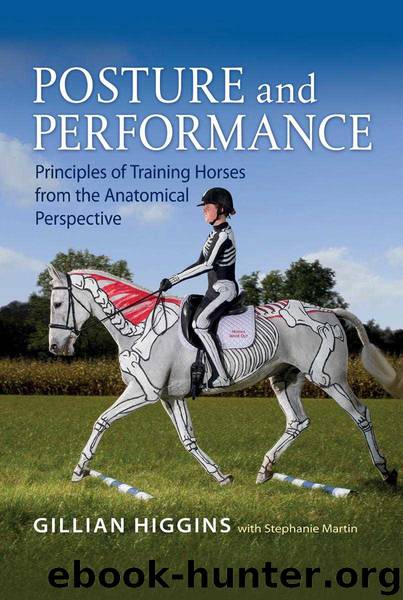POSTURE AND PERFORMANCE: PRINCIPLES OF TRAINING HORSES FROM THE ANATOMICAL PERPECTIVE by GILLIAN HIGGINS

Author:GILLIAN HIGGINS [HIGGINS, GILLIAN]
Language: eng
Format: azw3
ISBN: 9781910016077
Publisher: Quiller
Published: 2015-10-28T16:00:00+00:00
This pony had an extra vertebra between the 18th thoracic vertebra and the 1st lumbar vertebra.
Assessing straightness and symmetry during movement is as important as the static assessment.
Compensating for Asymmetry
When compensating for asymmetries in any part of the body, the effects may present as altered movement patterns in sites far removed from the original problem. For example, if the horse experiences pain in the jaw, this can have a causal effect on the poll, neck, forelimbs, back and associated movement patterns. This complex scenario varies from horse to horse.
Where the horse pushes unequally from behind, the forces being transferred forward will also be unequal. The arrows on the photograph indicate the possible flow of compensatory forces and this explains why horses can develop back pain as a secondary symptom of hindlimb lameness.
Download
This site does not store any files on its server. We only index and link to content provided by other sites. Please contact the content providers to delete copyright contents if any and email us, we'll remove relevant links or contents immediately.
Shoe Dog by Phil Knight(5141)
The Rules Do Not Apply by Ariel Levy(4861)
Walking by Henry David Thoreau(3893)
How to Read Water: Clues and Patterns from Puddles to the Sea (Natural Navigation) by Tristan Gooley(3406)
Running Barefoot by Amy Harmon(3397)
I'll Give You the Sun by Jandy Nelson(3358)
Crazy Is My Superpower by A.J. Mendez Brooks(3329)
How to Read Nature by Tristan Gooley(3249)
How Music Works by David Byrne(3186)
The Boy, the Mole, the Fox and the Horse by Charlie Mackesy(2998)
The Fight by Norman Mailer(2848)
Seducing Cinderella by Gina L. Maxwell(2604)
Cuba by Lonely Planet(2577)
Accepted by Pat Patterson(2302)
Going Long by Editors of Runner's World(2295)
The Unfettered Mind: Writings from a Zen Master to a Master Swordsman by Takuan Soho(2249)
Backpacker the Complete Guide to Backpacking by Backpacker Magazine(2193)
The Happy Runner by David Roche(2193)
Trail Magic by Trevelyan Quest Edwards & Hazel Edwards(2125)
